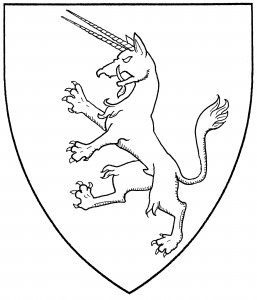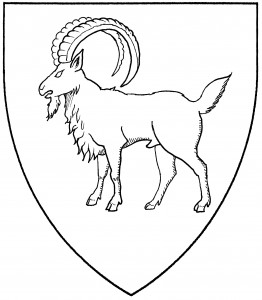The ibex is a monster similar to the antelope, but with forward-sweeping horns; it’s also called an “ebeck” in some period grants [Woodcock & Robinson pl.9]. The ibex was found in period armory as the badge of Audley, Lord Audley, d.1544 [Siddons I pl. 8; Woodcock & Robinson pl.19], and as the crest of Carill or Carrell, 1588 [Gwynn-Jones 104]. There doesn’t seem to be a default posture for the ibex; the illustration shows an ibex rampant.
When blazoned a “natural ibex”, the term refers to a beast, a species of mountain goat with distinctive circular horns. It too is found in period armory, most commonly in German armory, as in the arms of Windegg, c.1340 [Zurich 325]; the illustration shows a natural ibex statant. Since the two creatures have little in common but the name, Society heraldry grants difference between the ibex and the natural ibex.
Mary Taran of Glastonbury bears as a badge: An ibex rampant Or armed argent.
Cainder of Loch Suilli bears: Per pale ermine and sable, two natural ibexes rampant addorsed counterchanged.

